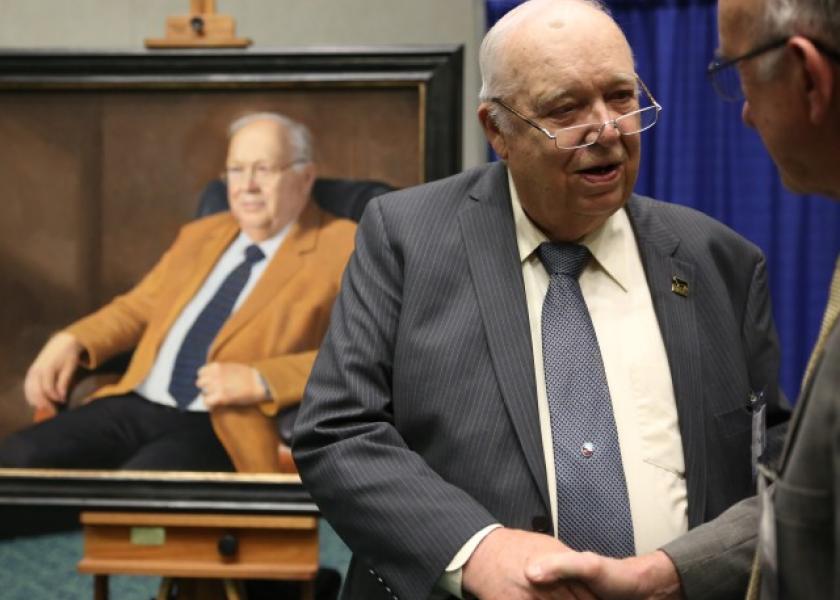I'm a Drover: Quite the Character

A little rough around the edges? Maybe. Quick as a whip? Most certainly. Sincere? Definitely. Whatever your opinion is of 2015 Saddle and Sirloin inductee Dave Nichols, there is one thing to be agreed upon: He is quite the character.
By: Laura Mushrush, assistant editor, Drovers CattleNetwork
Looking out across the southwest Iowa farm, there is a vast landscape of rolling hills speckled with black cattle grazing in the warm afternoon sun. Corn fields spot the area and a larger-than-life black bull named Stanley stands guard at the entrance as a giant welcome sign for Nichols Farms.
In the heart of it all sits Dave Nichols, himself, in a faded blue-jean jacket and a high-crowned red cap atop his white hair. While years of labor and living a long, telling life has aged him outwardly, an ornery glint and the spirit of a young man a quarter his age still dances in his blue eyes.
Turn the page back to the late 1930s; Merrill and Gladys Nichols were trying to make a living as dry-land farmers in Nebraska. On a prayer and hope for the end of World War II, Merrill packed up his family and bought a small farm in Iowa to start a cattle-feeding operation. His business model was simple: Pick up Hereford calves, finish them out and sell them at the Omaha Central Stockyards. As Dave became older, he tagged along with his father to learn the ropes of the business.
“When I was 9, we got a load of Hereford calves and off walked a black, white-face calf,” he recalls. “So dad sold him to me for a hundred bucks.”
He was in luck, turning a profit with his first investment. And as any cattle-feeder-at-heart would do, kid Nichols turned around and bought two calves with the money. But as any cattle feeder also knows, it doesn’t always go as planned.
“I lost my butt on those two calves!” he laughs. “By then I was 10 years old and couldn’t even pay off their original cost.”
Merrill wasn’t about to let a life lesson pass by without taking advantage of it and sent his son off to the bank to ask for a loan.
“I talked the banker into loaning me enough money to invest into four calves, saying I could pay it off with the profit they turned,” Dave says. “Well, he agreed to loan me the money on two calves, but I had to mortgage my bicycle — when he explained to me what a mortgage was, I decided borrowing money wasn’t what it was cracked up to be.”
Lessons learned
The years passed and Dave kept a hand in the cattle business, raising steers off the farm for 4-H. A reserve and grand champion trophy later, the teenager decided he liked what he saw in the purebred heifer barn.
“I told my parents I wanted to make the world a better place to live and to contribute so no child would go to bed hungry, so I wanted to get a purebred Angus heifer,” he recalls. “Truth is, the girls who were showing Black Angus heifers were wearing tighter jeans than the girls showing steers, and smelled better than the girls showing hogs.”
Shortly after, father and son were both in the heifer business. “Dad didn’t want to fool around with just the two-belt-buckle, short-legged heifers I bought, so he purchased 40 head,” Dave says.
Months later when the new herd’s calves hit the ground, they were the best the Nichols had ever seen. But something wasn’t quite right — Dave’s bull calf in the herd wasn’t growing, his forehead starting swelling and kept bloating. A veterinarian said it was probably because his mother had a uterine infection, and a feedyard nutritionist said it was a vitamin deficiency. An American Angus field man even advised Dave to “knock him in the head, bury him and don’t tell anyone.” But he wanted answers.
Eventually he found Jay Lush, a world-renowned geneticist at Iowa State University, who took Dave under his wing to teach him about the fundamentals of genetics, including knowledge about recessive genes for what was determined to be snorter dwarfism.
“Dwarf calves got to be quite a problem,” Dave recalls. “And in that time, if you wanted to know anything about the genetic trash of an animal, you either had to talk to a drunk or a kid because they were the only ones who would tell the truth.”
The Nichols crew assessed their herd situation and determined three of their four bulls had clean pedigrees and decided to market them to producers wanting guaranteed genetics.
“I put an ad in the local farm paper that said we had three bulls guaranteed not to sire dwarf or red calves; the next day our yard was full of pickups and cars from people wanting to buy the bulls,” he recalls. “It wasn’t until years later after dad had passed away, I realized the reason that yard filled up with people is because whatever Merrill Nichols said, that’s what it was. He ingrained in us, ‘Your word is better than your bond.’”
The dream team
In 1957, Dave was attending Iowa State University when a tantalizing opportunity came up.
“A farm came up for rent, so I dropped out of college to come home,” he says, adding that several years later his younger brother, Lee, had enrolled at Iowa State, and then decided to return home to join him. “Lee dropped out with a 4.0 GPA. The only time I had a 4.0 at Iowa State was my blood-alcohol level.”
Read more on CattleNetwork.com.







